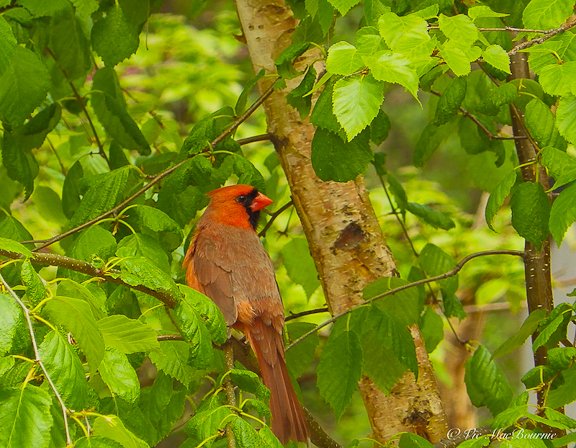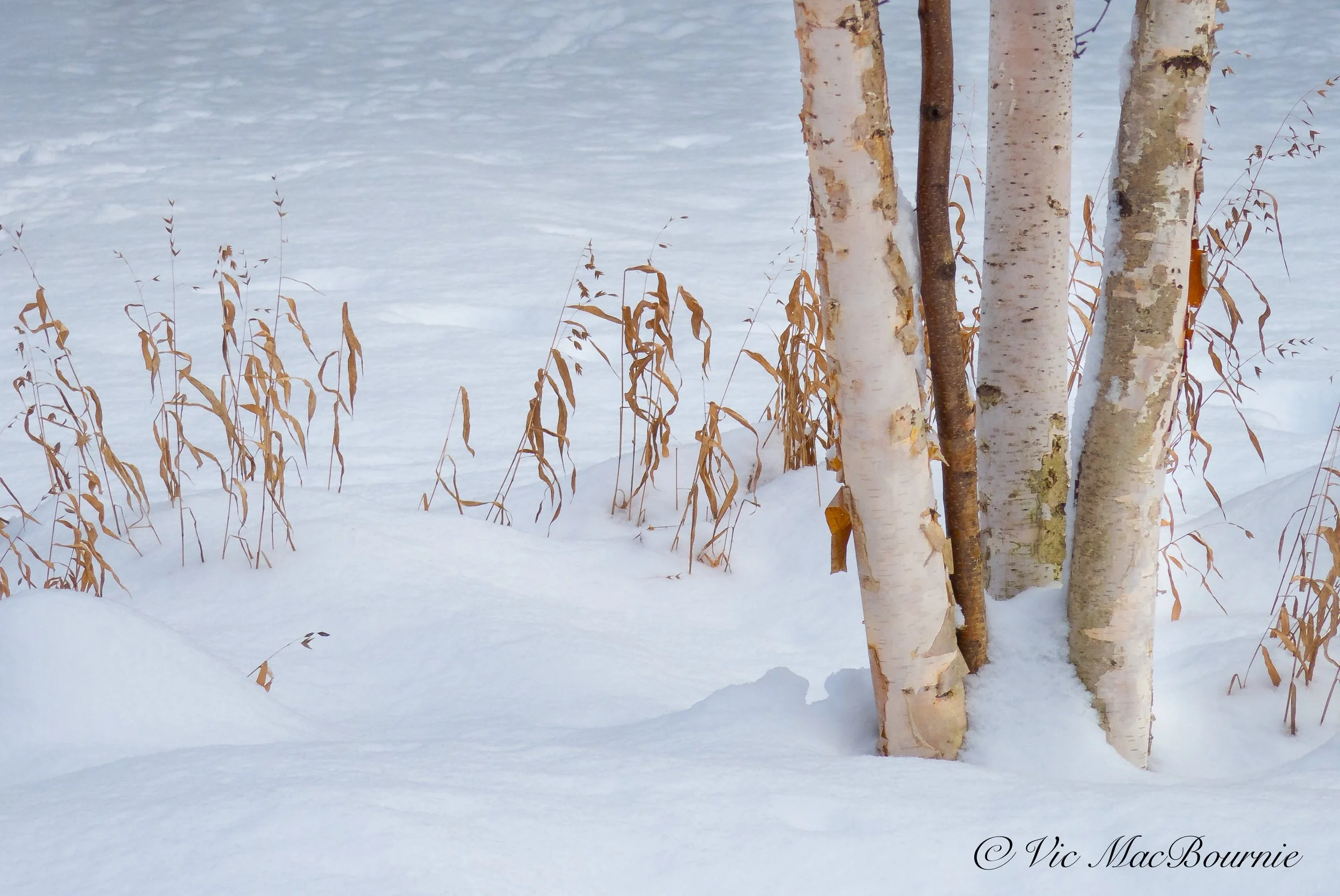Why we need more birch trees in our gardens
Are birch trees good for wildlife?
No matter how much I love dogwoods, it’s the birch trees that take centre stage in our woodland garden.
Three large clumps of White Birch create the main focal point in the backyard, whether you’re outside on the patio or looking out the bay window from the kitchen/dining room. I decided to plant the trees quite close to the house directly in front of the windows so we could experience everything they bring to the garden winter, summer, spring and fall.
The mini birch grove creates a secluded spot surrounding a dry river bed and small bubbling rock. For more on our birch grove and bubbling rock, check out my earlier post here.
While the elegant peeling bark and white trunks create the aesthetic appeal, it’s their attractiveness to birds and other wildlife that makes them true stalwarts in the garden.
Birds often sing from the tree’s elegant branches where, in spring, if you’re lucky, you can catch a warbler chasing insects around the tree branches. In summer, our birch trees make the perfect landing spot for hummingbirds that rest on the delicate branches in the open shade the trees create.
Birch trees are an elegant addition to any garden whether they are used as a single specimen, in clump form or en-masse as seen above.
“Birches are excellent sources of food for wildlife. Not only do they support several hundred species of moths and butterflies, they also produce seeds and flower buds that are important food sources for songbirds, small mammals, grouse and turkeys. Species with exfoliating bark provide lots of nooks and crannies in which insects hide in the winter months and thus provide woodpeckers with food when they need it most.”
Even in our front yard, I’ve created a spot for three narrow-growing birch trees (Betula pendula 'Purpurea' ) that work perfectly as an attractive buffer between us and our neighbours’ properties. I remember planting the trees at least ten years ago when they were nothing more than $10 whips. Since then, these fast-growing trees have grown into handsome specimens that have kept their narrow, shape while taking on their white trunks.
Birch trees, of course, are highly valued in gardens for their aesthetic appeal and their ability to attract diverse wildlife.
Their striking white bark and delicate leaves add a touch of elegance to any garden landscape, making them a popular choice among gardeners.
In his book The Natural Garden, Ken Druse writes about the non-native ‘Whitespire Birch’: “Many birch species have problems, but the beauty of their bark and their overall form make them desirable as specimens. … Plant several against a backdrop of evergreens. Because they are are relatively short-lived (50 to 70 years) consider planting a second some fifteen to twenty years after the first.”
Birch trees’ role in attracting wildlife
Beyond their beauty, birch trees play a crucial role in supporting wildlife populations.
The unique characteristics of birch trees make them a magnet for various bird species, such as chickadees and finches, that are drawn to the trees for both food and nesting sites. Additionally, birch trees provide a vital food source for insects, caterpillars and butterflies, further enhancing the biodiversity of the garden ecosystem and creating a built-in food source for birds.
It’s hard to argue that by planting birch trees in our gardens, we not only enhance the visual appeal of our outdoor spaces but also create a welcoming habitat for a wide range of wildlife. The symbiotic relationship between birch trees and wildlife underscores their value in garden settings, making them a cherished addition for both nature enthusiasts and garden lovers alike.
What birds are attracted to birch trees and why?
Birds are attracted to birch trees for a variety of reasons, making them a hub of avian activity in our garden.
The trees provide a valuable food source for birds, with their many small, winged seeds contained in the droopy catkins early in spring, followed by the leaves budding out, and the myriad of insects and caterpillars attracted to the trees.
You can expect species like the American Goldfinch, Purple Finch, Pine Siskin, Chickadees, Fox and Tree Sparrows and even Ruffed Grouse to drop by to feed on the seeds produced by the trees in spring.
But, of course it’s not just the seed eaters that are attracted to the trees.The real value of the birch tree are the insects that are drawn to them. Experts have documented several hundred species of Lepidoptera (moths and butterflies) that utilize birch trees.
In fact birch trees are host plants for butterflies like the Mourning Cloak as well as incredible moth species like the Cecropia, Polyphemus and the Luna Moth. The trees, therefore, are important to both the moths and butterflies as well as the birds that count on a good supply of these caterpillars to feed their nestlings.
Wherever there are insects and caterpillars, it’s likely you’ll find woodpeckers as well. Our birch trees attract more than their share of woodpeckers to the yard. While it can be a little disconcerting watching them peck away at your favourite tree, remember that they are actually doing you and the tree a favour by removing many of the potential borers before they can do damage.
In his book Bringing Nature Home, author Douglas Tallamy explains the importance of birch trees in our gardens adding that the tree supports more than 320 species and 413 Lepidoptera (moths and butterflies). Birches are not the top tree in the food chain, but they are among the best behind only oaks, willows and cherry/plums on the list of best trees to support wildlife.
Tallamy’s book points out that Birches are one of the host plants for the magnificent Tiger Swallowtail butterfly as well as the impressive Cecropia Moth, Imperial Moth, Luna Moth, Polyphemus Moth, Promethea Moths, Four-horned Sphinx Moth and Small-Eyed Sphinx moths. He adds that only the Arched Hook Tip moth and the Chocolate Prominent lepitdoptera survive only on birch tree leaves.
Tallamy writes: “Birches are excellent sources of food for wildlife. Not only do they support several hundred species of moths and butterflies, they also produce seeds and flower buds that are important food sources for songbirds, small mammals, grouse and turkeys. Species with exfoliating bark provide lots of nooks and crannies in which insects hide in the winter months and thus provide woodpeckers with food when they need it most.”
In our backyard, the cardinals like to use our birch trees to survey the area before moving in to the bird feeders or one of the many bird baths.
Our backyard birds rely on the trees not only for sustenance but also for nesting sites. As the trees get older, they can even be home to larger birds such as Great Horned owls.
The dense foliage and branches of birch trees offer a safe and secure environment for many birds to build their nests and raise their young.
What insects and butterflies benefit from birch trees?
Birch trees play a crucial role in supporting a diverse array of insects and butterflies within garden ecosystems.
These trees are particularly essential for the survival of various insect species, including the striking Mourning Cloak butterfly and the iconic Luna Moth. Additionally, birch trees provide a vital habitat for caterpillars such as the Eastern Tiger Swallowtail and the Viceroy butterfly.
In terms of insects, the birch tree serves as a host plant for the Bronze Birch Borer beetle, which plays a significant role in the decomposition process of decaying wood.
Furthermore, the Birch Leafminer moth relies on birch trees for its larval stage, contributing to the intricate web of interactions within the ecosystem.
Overall, the presence of birch trees in gardens not only enhances the visual appeal but also fosters a thriving community of insects and butterflies, highlighting the importance of these trees in supporting biodiversity and ecological balance.
What are the different species of Birch trees available?
Birch trees are known for their diversity, with several species offering unique characteristics and benefits to garden ecosystems. One of the most prominent species, native to northeastern U.S. and Canada, is the Yellow Birch (Betula alleghaniensis).
This species stands out for its distinctive yellow bark and its ability to thrive in cooler climates, making it a popular choice for gardens in these regions.
Another notable birch species is the Paper Birch (Betula papyrifera), recognized for its striking white bark that peels in thin layers, adding visual interest to garden landscapes. This species is well-suited for areas with moist soil conditions, making it a valuable addition to gardens near water features or wetlands.
“Many birch species have problems, but the beauty of their bark and their overall form make them desirable as specimens. … Plant several against a backdrop of evergreens. Because they are are relatively short-lived (50 to 70 years) consider planting a second some fifteen to twenty years after the first.Whatever it is, the way you tell your story online can make all the difference.”
Additionally, the River Birch (Betula nigra) is a favored choice for its unique exfoliating bark that reveals shades of cinnamon, cream, and salmon underneath. This species is particularly resilient to various soil types and can tolerate wet conditions, making it versatile for different garden settings.
Is the river birch the best birch tree for our gardens and why?
The River Birch (Betula nigra) is indeed considered one of the best birch tree species for gardens, and for good reasons.
Its unique exfoliating bark, showcasing shades of cinnamon, cream, and salmon, adds a visually appealing element to garden landscapes.
Moreover, the River Birch is highly adaptable to various soil types and can thrive in wet conditions, making it a versatile option for different garden settings. Its resilience to wet soil conditions sets it apart from other birch tree species, allowing it to flourish near water features, ponds, or wetlands without compromising its health.
Additionally, the River Birch provides valuable habitat and food sources for wildlife, attracting birds, insects, and other beneficial creatures to garden ecosystems.
How large do birch trees grow?
Birch Trees grown in favourable conditions can get quite large reaching from 30 to 65 feet high (9-19 meters) with a spread of 15-30 feet (4.5-9 meters). Birches are fast-growing, short-lived (50-70 years) trees, that do best in natural areas away from high-stress situations.
What conditions do birch trees like to grow?
Birch trees prefer well-drained soil that is moist but not waterlogged. They also appreciate full sun exposure, although some species can tolerate partial shade.
Birch trees’ shallow root system can be very sensitive to heat and drought. The trees need moist, cool soil, but also sunshine on its leaves to flourish.
Plant your birch tree at a site that will shade its roots in the afternoon but still provide sun to canopy for a good part of the day. Mulching also helps to maintain soil temperature.
Another crucial factor for birch trees is soil pH. They prefer slightly acidic to neutral soil, with a pH range between 5.0 and 7.5.
Additionally, birch trees are sensitive to drought conditions, so regular watering, especially during dry periods, is necessary to keep them healthy. Mulching around the base of the tree can help retain moisture and regulate soil temperature, benefiting the tree's growth.
By providing the right soil conditions, adequate sunlight, and proper watering, gardeners can create an optimal environment for birch trees to thrive and enhance the beauty and biodiversity of their outdoor spaces.
Author Profile: Vic MacBournie is a former journalist and author/owner of the award-winning website Ferns & Feathers. He writes about his woodland wildlife garden that he has created over the past 25 years and enjoys sharing his garden photography with readers.







